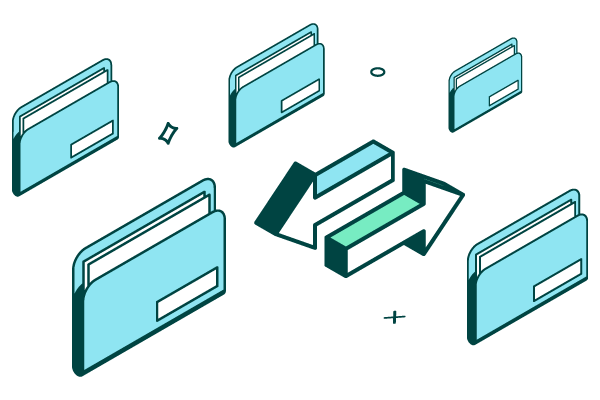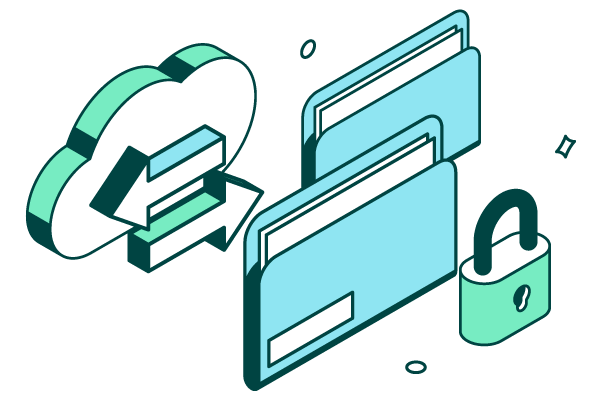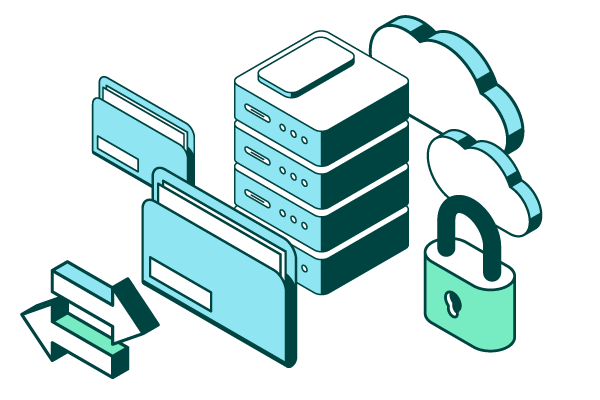What Is Managed File Transfer (MFT)?
Learn what managed file transfer is and how it can benefit your organization

What is MFT?
Anchor ID:
#what-is-mft-19496
Managed file transfer (MFT) is a technology platform that uses administrative controls, support for security protocols (like HTTPS, SFTP, FTPS), and automation capabilities to help companies securely share various types of data, including sensitive or compliance-protected data as well as high-volume data.

Why you Need MFT for File Transfers
Anchor ID:
#why-you-need-mft-for-file-transfers-19501
Managed file transfer solutions provide a more secure method of file transfer than standard file transfer protocol (FTP) and usually includes an interface and functionality that enables control and visibility.
MFT can be beneficial if your business requires:
- The ability to securely and reliably exchange files with business partners, including secure file sharing and secure online web transfers
- Control and visibility over your data movements and IT infrastructure
- A replacement for high maintenance, outdated, or non-compliant file transfer methods
- Communication and engagement with any of the industry-standard protocols such as FTP, FTPS, HTTP, HTTPS, AS2, and SFTP
Managed File Transfer for Windows
Anchor ID:
#managed-file-transfer-for-windows-19832
Discover Globalscape's Managed File Transfer Solutions
Anchor ID:
#discover-globalscapes-managed-file-transfer-soluti-19436

How is MFT Used?
Anchor ID:
#how-is-mft-used-20388
Secure, managed file transfer is used by organizations that recognize the need for sensitive or business-critical data to be protected both at rest and while in transit. MFT software supports multiple protocols so transfers in and out of the organization can be accomplished with a single, centralized tool, regardless of protocol.
Globalscape’s MFT platform gets sensitive or business-critical files from point A to point B while protecting that data at rest and in motion across networks and between endpoints. This protection is augmented by the ability to comprehensively manage or automate repetitive or unwieldly file transfer processes without the need for special programming or human intervention.
The solution’s user-friendly platform means that MFT can be adapted to internal and external needs for security, compliance, and integration with other business processes. Once installed, you can simply select the browser of choice to manage and share files securely.
You can define what protocols your users can use to connect to your server, help meet strict compliance mandates, and assure trading partners that sensitive information is protected end-to-end.

Managed File Transfer and Security
Anchor ID:
#managed-file-transfer-and-security-20389
Whether an organization must adhere to stringent compliance regulations, needs to work within trading partner security parameters, or simply knows protecting business-critical and sensitive data makes good business sense, secure MFT can help.
Globalscape’s Windows-friendly platform allows administrators to determine which secure protocols your users can use to connect to your server, such as HTTPS, SFTP, FTPS, AS2, and more. Once connected, based on permissions granted, full control over what can be done with a file is possible.
Functionality includes 2FA (two-factor authentication via the HTTPS protocol) as well as RSA SecurID advanced authentication for strong access control. In addition, Globalscape supports robust security such as TLS v1.3 and can provide Denial of Services to prevent unauthorized or brute force attacks into the server.
Secure file transfers can be protected even further when MFT is integrated with the ICAP Gateway for advanced threat protection and data loss prevention working to automatically scan and redact sensitive data or block malware.

Managed File Transfer Deployment
Anchor ID:
#managed-file-transfer-deployment-20390
Globalscape’s file security, simplicity and automation is the data transfer solution today’s organizations need. No matter which deployment is selected, ease of use is built in. Deploy on-premises, in the cloud, within your own hybrid environment, or even as MFTaaS, a cloud-based MFT service that provides the compliance and efficiency of MFT without the overhead of an on-premises solution. The following configuration options also provide the flexibility needed:
- Globalscape can respond to changing demands with EFT High Availability Active-Active configuration, allowing the addition of nodes to the cluster when demand is higher than usual.
- Additionally, there is integration support for Active Directory or LDAP, which allows EFT administrators to integrate with Windows to support user account creation or permission management.
- And Globalscape offers support for SAML SSO with Just in Time (JIT) that frees EFT administrators from creating user accounts and leverages the SAML system to provision users in EFT.
With workforces changing rapidly, knowing your secure MFT solution can adapt to your needs delivers peace of mind.
Anchor ID:
#tailor-your-deployment-strategy-to-your-specific-n-20392
| Cloud | On-Premises | Hybrid |
|---|---|---|---|
Help to meet compliance standards | |||
Automation tools | |||
Increased scalability |
| ||
Ability to utilize both on-premises and cloud servers |
|
| |
All work processes are performed in-house |
|
| |
Fast, controllable upgrades |
| ||
Complete internal control over all processes |
|
|
Anchor ID:
#how-mft-can-help-you-19431
Support Compliance Requirements
Securely Manage Sensitive Data
Managed file transfer software supports the secure management of sensitive data and helps improve data privacy. Whether it is proprietary data, employee or patient information, or credit card data, MFT minimizes endpoints that are commonly vulnerable when data is in motion. Add DLP via Secure ICAP Gateway to add an additional layer of data protection.
Enhance Operational Efficiency
MFT also offers efficiency and scalability benefits. It helps companies keep business operations in motion, even as their file transfer workflows grow in size, complexity, and volume. When strict SLAs are in place, MFT keeps data moving, instead of being stifled by inefficient, manual processes or an inflexible IT infrastructure.
See MFT in Action
Anchor ID:
#see-mft-in-action-19441
MFT Resources
Anchor ID:
#mft-resources-19466

Achieving Data Security through Managed File Transfer Software Solutions
Data security and productivity measures are far more successful when they are preemptive, which is why MFT solutions are an effective data management tool for many IT managers.

Hazards of a High-Maintenance MFT Platform
System complexity in a data transfer platform causes more than just a little staff annoyance. It could be costing your business precious time and resources, while setting you up for damaging security risks and downtimes.

Automate Data Exchange across Systems and Applications
Manual data transfer processes are vulnerable to manpower limitations and human error, making them inefficient and often unreliable. With automated data transfers, reduce manual work.
Anchor ID:
#faqs-20108
MFT stands for Managed File Transfer, which is a centralized file transfer solution that typically encrypts, automates, and centralizes data exchanges processes for businesses.
Managed file transfer solutions are often a more secure file transfer method than standard protocols like FTP. They offer stronger file transfer protocols, encryption methods, and grant visibility into data movement and user access.
Managed file transfer is a key piece of data security. Using and sharing data is a given, and MFT solutions help organizations move data securely. As one of the most robust methods of secure file transfer out there, MFT helps you protect your data when it’s most vulnerable: in transit.
Users of an MFT solution set up file transfers within the MFT application. Once the transfer is outline—who the recipient is, which protocol to use, when to send, and how often to send—the MFT solution encrypts both the data and the transfer itself. The data is then transferred from the sender’s server to the recipient, who can decrypt the data.
Each managed file transfer solution brings different strengths to the table. When in the market for MFT, consider any industry-specific requirements you must meet, compliance needs, and of course, the types of transfers your MFT solution will be performing. Whether you want to deploy the solution on-premises, in the cloud, or via a SaaS solution will also impact which MFT solution is best for your organization.
Thinking of these requirements ahead of time will help you implement the best MFT solution for your needs. There are several key players in the MFT space, and many ways to compare them. Testimonials and reviews on software review sites, like Gartner Peer Insights, Capterra, or G2, or demos and trials can help you identify the features that each solution offers.